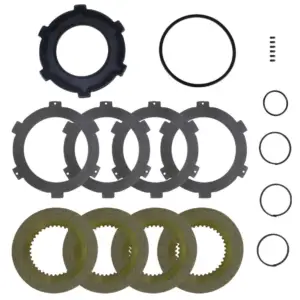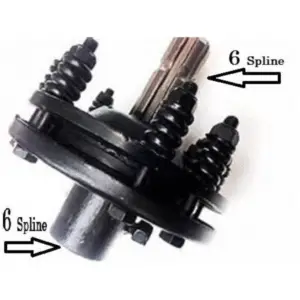Table of Contents
 PTO clutches are typically utilized with outdoor power equipment to start and carry out a cutting blade’s rotation. The implementation is also slowed considerably whenever the clutch is disengaged. PTO Clutch is a vital part of your lawn tractor; if it goes bad, you must replace it.
PTO clutches are typically utilized with outdoor power equipment to start and carry out a cutting blade’s rotation. The implementation is also slowed considerably whenever the clutch is disengaged. PTO Clutch is a vital part of your lawn tractor; if it goes bad, you must replace it.
It is necessary to replace the bad PTO clutch. If not it can damage the other part of the machine. To exchange the bad PTO clutch with new one first we must know the symptoms of a bad PTO clutch.
See our review and buying guide on Best Mulching Lawn Mowers.
In this article, we will tell you the purpose of a PTO clutch, the symptoms of a bad PTO clutch, and when to exchange it for the new one.
Purpose Of PTO Clutch
The PTO clutch is located behind the engine and connected to the transmission shaft. It’s a spring-loaded mechanism that helps you change directions when operating your lawnmower or similar piece of equipment.
Purpose
The purpose of this system is to prevent excess strain on other engine components when trying to operate under heavy load conditions (such as cutting grass). This can lead to damage over time if not properly maintained or repaired by an expert mechanic who knows how things work inside out!
Symptoms Of Bad PTO Clutch
A good way to know that the clutch is going bad is when you have trouble removing the PTO switch from its socket on the dashboard. Another sign of a worn-out PTO clutch is when you hear noise coming from behind your lawn mower‘s engine.
If there is a problem with the PTO clutch, the following symptoms will appear.
Mower Blades Stop Dead
One sign that you have a problem with the clutch is that the mower blades stop dead in their tracks when you disengage the blades at the control level. If that happens, it’s likely because your clutch has failed and needs to be replaced.
Clutch Won’t Engage
Another sign that the clutch is going bad is when the clutch won’t engage at all. This can be not easy to notice, because your mower may still run fine and drive well if this happens. If you do notice this issue, however, you’ll likely have to replace your PTO clutch before too long.
If it’s not engaging with ease or has any other issues that prevent the smooth operation of your transmission system (such as rough shifting), then there’s a big chance that something needs to be repaired or replaced for everything else—including yourself—to look after itself properly again.
If the blades are not disengaged and engaged, they will be damaged by running in reverse all day long. This will result in more damage to the engine over time and require more work on your part as well as cost money for repairs or replacement parts.
Trouble Removing The PTO Clutch

If you have trouble removing the PTO switch from its socket on the dashboard, your PTO clutch may be going bad. This can happen because there may be a cover or plug covering up one of these sockets.
You may need to remove a cover or plug to access this socket and then use a screwdriver for you to remove this part from its socket (if needed).
Noise Coming From Mower Engine
Another sign of a worn-out PTO clutch is when you hear noise coming from behind your lawn mower’s engine. You may find out that your lawn tractor engine starts and runs normally but then begins to make noise after working for some time.
This could indicate that something isn’t working properly within the engine itself but could also mean that something else has been damaged by overuse or misuse.
- The noise may be coming from the engine.
- It may be coming from your clutch.
- Sometimes, both are at fault and you’ll need to replace one or both of them together.
If you hear an odd noise coming from inside when operating your PTO switch, it could be due to grinding gears inside of them causing noise while spinning at high speeds (25-35 mph).
This type of sound can also indicate some other issues such as worn-out bearings or loose pulleys which would cause excessive vibrations through transmission system components causing excessive wear on them.
No, Respond When Pressing PTO Switch
You may notice that nothing happens when you press your lawn tractor’s PTO switch and this could be a sign of wear. If your lawn tractor’s PTO switch does not work, you may experience one or more of these symptoms:
- The clutch doesn’t engage.
- The engine stalls out when you use the PTO switch.
- The Clutch Light comes on and stays on, even if you press the clutch pedal with no load on it.
- In this case, there is likely a problem with your transmission or axle shafts (the part that connects them to their respective wheels).
- If this happens, then your transmission may need replacing before anything else can be fixed
Solution For Bad PTO Clutch Symptoms
There isn’t a single remedy for the PTO clutch issues and it depends on the situation the conditions of the PTO clutch are:
- For instance, you need to repair the clutch if the PTO clutching solenoid is faulty.
- However, if the issue is with a switch, that switch must be replaced to fix the issue.
- Additionally, for the best performance, the PTO clutch, particularly electric clutches, must be adjusted.
- If not, you will see the space between the contact plates, which lowers the complexity and power of the magnets holding them together.
- Due to the possibility of the contact plates slipping under a heavy load, heat will be generated from the friction of dropping.
- Sometimes fixing frequent problems and ensuring peak performance can be accomplished by periodically adjusting the PTO clutch.
How Is A PTO Clutch Removed?

Fortunately, removing a PTO clutch doesn’t require any specialized tools or equipment. All you need is a screwdriver, a set of socket wrenches, and some excellent gloves. Having gathered those tools, let’s go on to the removal phase:
- First, detach the spark plugs to lower the risk.
- The plastic covering that shields the pulley from harm and protects the belt must then be removed.
- To access the clutch, first, loosen the blade belt.
- You’ll discover two sets of wires that are connected to the PTO clutch straight after removing the belt. Before releasing the clutch, disconnect those cables.
- A helper is undoubtedly required for this phase. The top of the mower and vehicles are connected with a bolt. Along with unscrewing the bolt, have your helper hold the nut in place as you remove the flywheel cover with a screwdriver.
- Once the bolt is out, you can finally take the PTO clutch out.
Conclusion
An essential piece of machinery used on modest tractors to turn on mower tillers or blades is the power takeoff clutch. Electricity is utilized to create a magnetic armature that rotates the blade.
However, you must undertake routine maintenance on it to achieve the best performance. Now that you know how to check for a bad PTO clutch, you can save yourself a lot of money and headaches by fixing your lawn tractor’s clutch before it becomes too expensive to fix.
